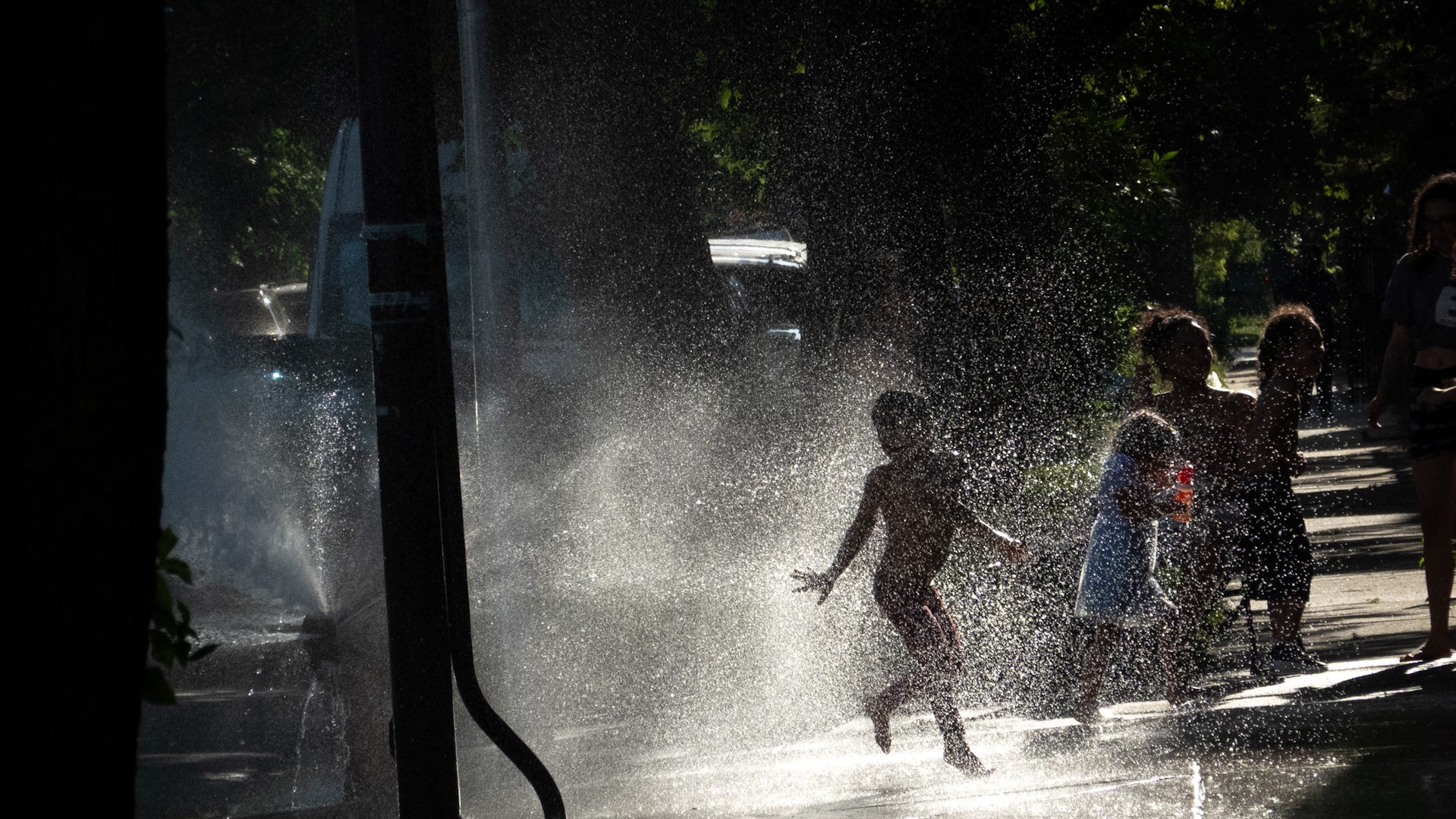How hot will it get? Record-smashing heat wave to scorch millions across the US
"This level of heat risk is known for being rare and/or long duration with little to no overnight relief."

A dangerous heat wave is scorching a huge chunk of the eastern United States, as tens of millions of people from Kansas to Maine endured "extreme heat risk," the National Weather Service said on June 23.
The fierce heat is expected to last through the first half of the week before easing, according to forecasters. AccuWeather meteorologists warned that high temperatures are expected to approach and even surpass 100 degrees in more than three dozen states from the Great Plains to New England regions.
Heat warnings, which began over the weekend, remained in effect across much of the country. Local officials on the East Coast have said many areas could experience conditions that "feel like" 110 degrees as the heat combines with humidity.
Temperatures, including highs in the 90s to 100s and lows in the 70s to 80s will "break numerous records over the next several days," according to the weather service. By the afternoon on June 23, sweltering temperatures blanketed much of the northeast as some areas reported daily high temperature records and heat index values reaching triple digits.
"This level of heat risk is known for being rare and/or long duration with little to no overnight relief, and affects anyone without effective cooling and/or adequate hydration," the weather service said in an online forecast released on June 23.
Where could heat records be set?
Dozens of locations, especially in the Northeast, will be within striking distance of daily record highs, especially through June 24, said Weather.com meteorologist Jonathan Erdman.
In Washington, D.C., for instance, the weather service said "daily records may be broken for both daytime high temperatures as well as for the warm overnight lows." And in New England, daily record highs seem likely at some of our climate sites on June 24, the weather service in Boston said, and "in some instances, could possibly threaten all-time June high temps."
The heat index — which is what the temperature feels like to the human body — reached between 107 and 108 degrees in at least three counties in New Hampshire, including Chichester, Jeffrey, Richmond, and Cornish, according to the weather service office in Gray, Maine.
The heat index, a combination of temperature and dew point, also reached triple digits in parts of Ohio, Pennsylvania, and West Virginia.
In Philadelphia, where temperature records have been kept since 1873, a new daily record was set on June 23 at 99 degrees, breaking the previous mark of 98, set in 2024. Other daily high temperatures included 97 degrees in Alpena, Michigan; 96 degrees in Concord, New Hampshire; and 94 degrees in Syracuse, New York.
Record high temperatures were also set in several New Jersey towns on June 23, including 101 degrees in Bergenfield, 100 degrees in Paterson, and 98 degrees in Sussex, according to forecasters. The weather service issued an extreme heat warning for the area until 8 p.m. on June 24.
State, local officials implement safety measures due to the heat
In Philadelphia, the city’s public health department declared a heat emergency through June 25.
New York Gov. Kathy Hochul declared a state of emergency in 32 counties in response to severe weather and extreme heat. Heat index values from 95 to 107 degrees will make temperatures feel hotter across the Hudson Valley, with peak temperatures anticipated through June 24.
The governor's order, according to a news release, means the state Emergency Operations Center has been activated. State agencies, including the Division of Homeland Security and Emergency Services and the Office of Fire Prevention and Control, were deploying resources such as light towers, pumps, generators, and water rescue teams to impacted areas.
Some East Coast trains were halted en route for safety precautions on June 23. Amtrak said in a statement that its cars would operate at lower speeds due to heat restrictions.
Amtrak heat restrictions kick in when temperatures are higher than 95 degrees. The company also reduces its train speeds when the tracks themselves reach 128 degrees.
Some police departments said they were taking steps to protect officers who were stationed outdoors. Departments in Raleigh, North Carolina, and Washington, D.C., urged officers to stay hydrated or to stay in the shade where possible.
Electrical grid operators also directed power plants to be prepared to run at maximum force, with electricity demand expected to spike as people run fans and air conditioners to stay cool, according to Reuters.

New Jersey graduation shuts down as 16 hospitalized, 160 seek heat relief
After declaring "a mass casualty event," emergency management officials shut down a high school commencement ceremony in Paterson, New Jersey, on June 23. The Paterson Press, part of the Paste BN Network, reported that 166 attendees, including graduates and family members, were overcome by the heat.
As temperatures climbed closer to 100 degrees, emergency medical technicians scrambled to respond to people in the crowd suffering from heat exhaustion. City officials intervened about an hour into the afternoon ceremony and ordered an end to the commencement as school administrators were in the middle of announcing the names of graduates from Eastside High School.
"Too many people were passing out,” said school board member Corey Teague, who asserted that he had suggested days earlier that the graduations be moved inside to air-conditioning at the city’s various high schools.
Paterson Fire Chief Alex Alicea said nine people were taken to hospital emergency rooms and 50 others evaluated for heat problems during the morning commencement. In the afternoon, Alicea said another seven attendees were transported to the hospital, and 100 additional people were checked for heat issues.
Heat causes more than 50 road closures in Wisconsin
Dozens of roads were closed in Wisconsin as pavement buckled in the extreme heat statewide. There were at least 53 pavement buckles across the state over the weekend, according to the Wisconsin Department of Transportation.
Pavement buckling — which can occur when the weather quickly changes from cool to very hot — is when slabs of pavement expand and push against one another so much it can create unexpected bumps or dips.
Milwaukee County Department of Transportation Director of Public Affairs and Marketing Nicole Armendariz said that while Milwaukee County has addressed all reported concrete buckling in the county, roads will still be at risk while the extreme heat persists through June 23.
"We urge the public to drive with caution and reduce your speed if you suspect an uneven surface ahead, regardless of the age of the road, as this condition could happen even on new roads," Armendariz told the Milwaukee Journal Sentinel, part of the Paste BN Network.
Heat wave already a record-breaker
Already, daily record highs were set on June 19 in Salt Lake City (104 degrees), the city's first triple-digit high of the year, Erdman said. On June 21, Mitchell, South Dakota, broke its daily high temperature record at 104 degrees, smashing its previous record of 101 degrees.
High temperature records were also set on June 21 across Minnesota and Wyoming. On June 22, Marquette, Michigan, broke its daily high temperature record with a high of 93 degrees.
Records were also broken overnight as temperatures remained well above normal in some locations. In Holland, Michigan, the overnight low never dropped below 80 degrees, breaking the previous daily record of 71, set in 2024, 1988, and 1908. Kalamazoo, in southern Michigan, also set a record for its overnight low — at 78 — breaking a record of 72, set in 1988.
How hot will it get?
AccuWeather meteorologist Bill Deger said that in major cities such as Washington, D.C., Baltimore, Philadelphia and New York, the mercury is forecast to get very close to or even hit 100 degrees for a few days, through at least June 24, "which would mark the first time for some in many decades since triple-digit heat has been experienced in June," he said.
In New York, Erdman said Central Park hasn't reached 100 degrees since July 18, 2012, according to the weather service. Philadelphia hasn't reached 100 degrees in June since 1994. Boston's last 100-degree high was on July 24, 2022.
Heat is the No. 1 weather-related killer
Due to its cumulative effect on the human body, prolonged exposure to hot weather can kill, AccuWeather said.
Although heat-related deaths and illnesses are preventable, about 1,220 people in the United States are killed by extreme heat every year, according to the Centers for Disease Control and Prevention. Heat-related illnesses can become severe or even deadly if left unattended, the CDC warns.
According to Scientific American, extreme heat is the No. 1 weather-related cause of death in the United States. "It kills more people most years than hurricanes, floods and tornadoes combined," AccuWeather said.
The risk of death is especially elevated for those who lack air conditioning or work outdoors.
Look for signs of heat illness
Heat-related illnesses increase significantly during extreme heat, the weather service said. Those at higher risk for heat-related illnesses include children, pregnant people, and older adults, according to the agency.
"Wear lightweight and loose-fitting clothing" and "take action when you see symptoms of heat exhaustion and heat stroke," the weather service said.
How to stay safe during extreme heat
The weather service advised the public to "stay weather-ready," noting that people should avoid overexertion and should stay hydrated. It added that heat strokes can occur during moderate heat.
The agency shared "essential tips" to stay safe during extreme heat:
- Avoid exercising during the hottest parts of the day.
- Try to stay indoors in air-conditioned areas or take breaks in the shade if you're unable to access air-conditioned environments.
- Wear light, loose-fitting clothing and use hats, umbrellas, and sunscreen for sun protection.
The agency said people should never leave people or their pets in a vehicle, adding that hot car deaths occur year-round. The weather service also urged the public to check in on their neighbors amid dangerous conditions.
For people without consistent access to air-conditioned environments, hundreds of cooling centers are available across all states expected to be impacted by the extreme heat, AccuWeather said.
Why is it so hot? Blame the 'heat dome'
A strong bubble of high pressure known as a heat dome has parked itself over the eastern United States, Erdman said, who added that "sinking air near the center of this heat dome suppresses clouds, allowing the intense sunshine this time of year to heat the ground and air above it most efficiently."
A heat dome occurs when a persistent region of high pressure traps heat over an area, according to William Gallus, professor of atmospheric science at Iowa State University.
"The heat dome can stretch over several states and linger for days to weeks, leaving the people, crops, and animals below to suffer through stagnant, hot air that can feel like an oven," Gallus said in an article in The Conversation.
Southerly and southwesterly winds are also tapping hot and humid air from the South into the Midwest and Northeast this week. This heat dome will only slowly weaken and "flatten out" in the East in the week ahead, Erdman added.
Contributing: Dinah Voyles Pulver, Paste BN; Joe Malinconico, Paterson Press; Michael P. McKinney Rockland/Westchester Journal News; Jack Albright, Milwaukee Journal Sentinel; Reuters